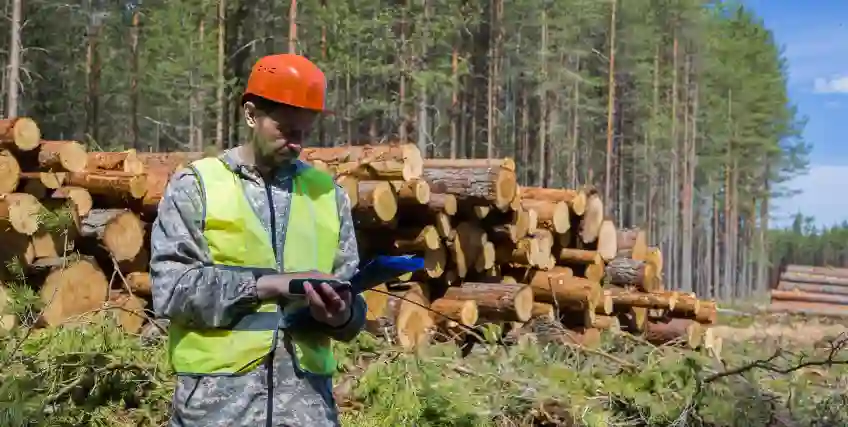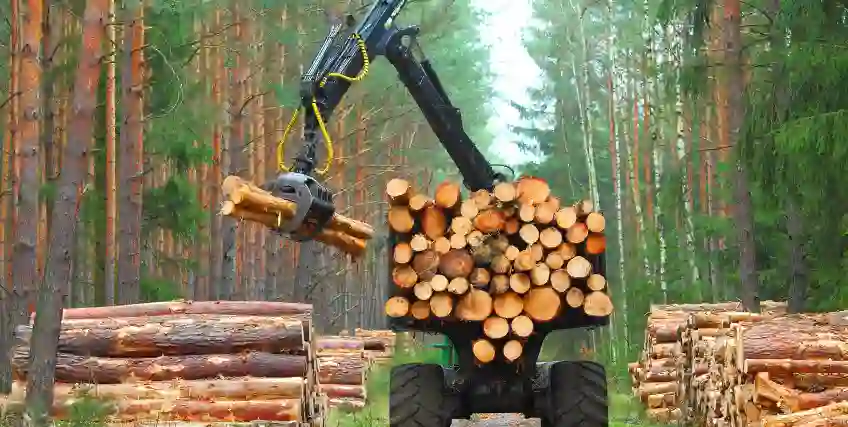Working Capital Loans for Forestry Operations What You Need to Know
Jul 24, 2025 | Last Updated on: Jul 28, 2025

Forestry operations are the backbone of the timber and paper industries, but running a logging business isn’t cheap. From purchasing heavy-duty machinery to covering seasonal cash flow gaps, the financial challenges of this industry are a constant concern for business owners and operators.
Many logging companies struggle to balance the high costs of forestry equipment with unpredictable revenue cycles. That’s where logging equipment financing and working capital loans can be useful tools to bridge those gaps. These financing solutions help forestry businesses manage day-to-day expenses, pay for new equipment, and take on bigger projects without disrupting cash flow.
Here’s a look at logging equipment financing options, how to secure business loans for your operation, and whether leasing might be better for some of your heavy equipment needs than buying.
Why Forestry Operations Need Working Capital
The seasonal logging industry has unique and sometimes complex cash flow challenges. Unlike businesses that generate steady income year-round, logging companies often have big delays when it comes to getting payments from mills or timber buyers. At the same time, their small business expenses don’t ever stop, whether that means paying for fuel, maintaining pieces of equipment, covering payroll, or paying insurance premiums.
Some of the most common reasons your forestry business might need to turn to a business loan or logging equipment financing solutions include:
- You need to cover everyday operating costs: From fluctuating fuel prices to pricey equipment maintenance, it can cost a lot just to keep your business afloat each day.
- Payroll needs to be covered for employees: Even when logging slows down, your workers still need to be paid (at least, if you want to keep them).
- There are unexpected or emergency expenses: Whether dealing with storm damage or making an un-budgeted equipment purchase after something breaks down, unplanned expenses can throw off operations if you don’t have a financial cushion.
- You want to grow your business: Expanding into new territories, buying out a competitor, or even just upgrading your equipment can be expensive, especially if you don’t have the cash on-hand.
For many businesses, forestry equipment loans can be the answer to keeping operations running smoothly while also giving you access to the cash you need, even during slow seasons or revenue slumps.
How Logging Equipment Financing Works
Logging equipment financing are designed to help forestry businesses buy or lease heavy machinery. They provide you with an upfront lump sum that is used to purchase equipment from a seller, which you then pay back over a series of agreed payments. Unlike business lines of credit or other loans, equipment financing is secured by collateral in the form of the machinery you want to buy.
There are many different types of equipment needed to harvest and transport timber, from feller bunchers and loaders to log trucks, chippers, mulchers, and chainsaws. But even though this machinery comes with a hefty price tag, it can be critical to your operation. If you don’t have the cash available to buy new or used equipment, a logging equipment loan can help.
Here’s how logging equipment financing typically works:
- Repayment terms: Logging equipment loans often have flexible terms for repayment. The exact loan term you’re offered can depend on the lender you choose, the age and condition of the equipment you want to buy, and even your business credit history.
- Interest rates: This represents the “cost” of borrowing a forestry equipment loan, and is based on creditworthiness, how much you need to borrow, and how long you want to repay the debt. Logging equipment financing rates vary by lender.
- Down payments: Equipment loans often require borrowers to put down some of the equipment purchase price, often ranging from about 10% to 25%. However, some lenders offer 100% financing programs for qualified borrowers, especially when buying new equipment.
- Repayment: Monthly payments (or sometimes, seasonal payments) can sometimes be adjusted to match your business finance needs, such as your individual cash flow cycle.
Forestry equipment financing lets you buy the machinery you need without having to cough up the cash upfront. This allows you to keep your working capital for other operational needs, like labor costs and fuel or emergencies. By financing, you may also be able to buy newer, more efficient equipment that not only requires less maintenance but helps your business make money faster.
Types of Forestry Equipment Loans and Leasing Options
Depending on your budget and long-term business goals, here are a few different logging equipment loans or leases to consider.
Traditional Equipment Loans
These “typical” loans give you an upfront lump sum that you can then use to buy equipment and cover other business expenses. You’ll repay the debt over an agreed period of time with interest, while the lender may or may not use the equipment as collateral to secure the debt.
These business loans can be a good option if you want to keep the equipment in the end, since you will own it free and clear once your loan is repaid.
Traditional equipment loans are available through banks, credit unions, online lenders, and other business finance companies. Especially if opting for an unsecured loan, you will need to meet certain loan requirements in the application process before you get approved. This might mean having a certain credit score or providing bank statements and financial documents that show you can repay the debt.
Forestry Equipment Leasing
Leasing allows you to essentially “rent” the equipment you need for a specific period of time, often with the option to buy it at the end of the repayment term. This gives you the flexibility to try out equipment before committing to it in the long-term. It also has lower upfront costs compared to buying machinery outright, and may even let you stay in newer equipment than if you were just paying in cash.
Operating leases usually let you return or upgrade the equipment at the end of your lease term, and can have lower monthly payment requirements. On the other hand, finance leases function more like a traditional loan, but also with an equipment purchase option at the end.
Vendor Financing Options
Some manufacturers or equipment dealers offer in-house financing at competitive rates, especially when buying new machinery. This can be a good option for start-ups that don’t yet qualify for traditional loans or don’t want to go through a lengthy logging equipment financing process with a bank.
How to Choose the Right Logging Equipment Financing Option
Not all logging equipment financing is created equal, and the right one for your forestry business isn’t necessarily the one that’s right for your competitor. To figure out which financing option is best for you, there are a few questions you should ask yourself.
- How long do I want to keep this equipment: Be sure your loan term matches the length of time you plan to use the machine (and how long it will last), especially if you plan to upgrade sooner than later. If you want new equipment on a regular schedule, leasing may actually be the better option.
- How much will this cost me in the end: The price of your new log loader or sawmill isn’t just its monthly payment: it’s how much the equipment plus your logging equipment financing option will cost you. Be sure to factor in interest charges and fees when evaluating your options to get the full financial picture.
- Can I make this payment each month: Logging companies have notoriously variable cash flows. Even if you can handle your equipment’s monthly payment now, can you also handle it during a slump or slow season? No matter which logging equipment financing option you go with, be sure to compare offers from multiple lenders first before committing to anything. This will help you find the most affordable option and save your business money.
Final Thoughts
Running a successful forestry operation takes more than skill and hard work — it also takes smart financial planning. Whether you’re buying a new harvester, upgrading your delimbers, or managing fuel and payroll during the off-season, logging equipment financing can give you the capital you need to stay efficient, competitive, and sometimes, afloat.
Be sure that you understand all of your options for forestry equipment loans, leasing structures, and working capital solutions before choosing. This can help you make informed decisions that support your business today and in the future, investing in yourself as you grow.
FAQs on Logging Equipment Financing
Why do forestry operations need working capital loans?
Forestry businesses have unique, seasonal cash flow challenges, often stemming from delayed payments from mills or buyers. Working capital loans can help cover payroll, fuel costs, insurance, equipment maintenance, and emergency repairs during these cash flow gaps, helping business owners maintain smooth operations all year long.
What types of forestry equipment can be financed?
Most equipment lenders allow financing for a range of essential machinery, including feller bunchers, skidders, forwarders, log loaders, chippers, mulchers, logging trucks, and trailers. This machinery can often be financed with a secured equipment loan or purchases with an unsecured, traditional business loan or line of credit.
Is it better to lease logging equipment or buy it?
Equipment leasing offers lower upfront costs and the flexibility to upgrade your equipment at the end of your term, making it a good choice for businesses that always want (or need) the latest machinery. On the other hand, buying with logging equipment financing gives you the security of equipment ownership and long-term value through that equipment’s equity.
Can forestry businesses get flexible payment plans?
Many lenders understand the seasonal needs of forestry businesses, and offer seasonal or deferred payment plans to those types of companies. This lets businesses make larger payments during high revenue months and smaller payments during slower seasons.
Are there tax benefits to financing forestry equipment?
Section 179 of the IRS tax code lets businesses deduct up to the full purchase price of qualifying equipment in the year it’s put into service. This deduction applies even if you use logging equipment financing to buy rather than purchasing your equipment outright. However, be sure to consult a tax professional for advice before making any decisions regarding the tax code.
Frequent searches leading to this page
Term Loans are made by Itria Ventures LLC or Cross River Bank, Member FDIC. This is not a deposit product. California residents: Itria Ventures LLC is licensed by the Department of Financial Protection and Innovation. Loans are made or arranged pursuant to California Financing Law License # 60DBO-35839




